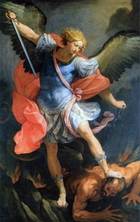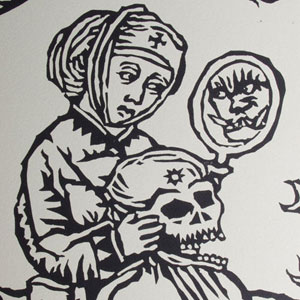The Intrigue Science Of Possession.
August 18, 2010What Is Demonic Possession?
Both the Catholic Church and numerous evangelical Protestant denominations still hold to a firm belief in the existence of demonology and demonic possession. According to the Catholic Encyclopedia, this belief is rooted in church doctrine.
All too often, however, demonic possession is used to explain psychological conditions that have nothing whatsoever to do with notions of demonic possession. This applies to personality disorders, and especially sufferers of bipolar disorder and, broadly, schizophrenia.
Equating mental disorders with demonic influence can be traced back to the 1509 publication of the Malleus Maleficarum by Heinrich Institoris and Jacob Sprenger. Linking witchcraft with demonic activity, the Malleusmerged long-held distinctions between insanity (going back to Roman law) and demonic possession.
To a certain extent, all manner of “evil supernatural figures,” such as ghosts and demons, were said to be part of a pantheon of malevolent beings tied to the devil. This had been a belief of the Christian Church for centuries.
But the Church, prior to the Malleus, had accepted insanity as a viable distinction, taking their cue in Canon Law from Roman law. Every soul was consigned to a specific place within the cosmology of the church. Hence, demons and even ghosts could not possibly be confused with human souls. This thinking would change during the sixteenth century as scholars began to differentiate between the so-called crime of witchcraft (and concurrently, possession) and insanity.
The Online encyclopeadia Wiki Says:
 Spirit Possession is the belief in paranormal, supernatural, psychological and/or superstitious spirits, gods,demons/daemons (demonic possession), animas, extraterrestrials, or other disincarnate or extraterrestrial entities taking control of a human body, resulting in noticeable changes in health and behavior. The concept of spiritual possession exists in many religions, including Islam, Christianity, Buddhism, and Haitian Vodou and African traditions. Those who profess a belief in demonic possession have sometimes ascribed similar symptoms to those associated with mental illnesses such as psychosis, hysteria, mania, Tourette's syndrome, epilepsy,schizophrenia or dissociative identity disorder to possession. A constant feature of possession is involuntary, uncensored behavior, and an extra-human, extra-social aspect to the individual's actions. He is dehumanized, bereft of normal powers of recognition and reaction, and his speech and movements are distant from the societal norm. In the cases of animal possession, the individuals deportment suggests that of an animal.
Spirit Possession is the belief in paranormal, supernatural, psychological and/or superstitious spirits, gods,demons/daemons (demonic possession), animas, extraterrestrials, or other disincarnate or extraterrestrial entities taking control of a human body, resulting in noticeable changes in health and behavior. The concept of spiritual possession exists in many religions, including Islam, Christianity, Buddhism, and Haitian Vodou and African traditions. Those who profess a belief in demonic possession have sometimes ascribed similar symptoms to those associated with mental illnesses such as psychosis, hysteria, mania, Tourette's syndrome, epilepsy,schizophrenia or dissociative identity disorder to possession. A constant feature of possession is involuntary, uncensored behavior, and an extra-human, extra-social aspect to the individual's actions. He is dehumanized, bereft of normal powers of recognition and reaction, and his speech and movements are distant from the societal norm. In the cases of animal possession, the individuals deportment suggests that of an animal.
Now lets see How the catholic church see it....
Catholic Church’s Teaching on How to Identify the Devil’s Influence. The Catholic Church teaches two possible ways demons torment humans - the classic demonic possession of movie fame, and the more common but less-known demonic obsession.In a 2010 interview with CNN news, Father Gabriele Amorth — known as the Vatican’s top exorcist and founder of the International Association of Exorcists — warned the world that demons are real and influence the lives of believers and the Church.
Though demonic possessions are said to be rare, knowing how to identify a possible demonic influence may reassure and inform those who believe that demons are real and active in today’s world.
Types of Demonic Influence in Catholic Teaching
There are two major ways that demons influence people, according to Catholic teaching. Demonic possession, the most famous and serious condition, is when a demon takes complete control of a human being’s mind and body. Demonic obsession, or influence, is when a demon tempts an individual repeatedly in attempts to lead him or her into hurting self or others.
Demonic Possession in the Catholic Church
Demonic possession of Exorcist fame is the most serious form of demonic influence. An individual loses all control over himself/herself when possessed by the devil and is like a puppet moved by a demonic hand. Friends or family members may not recognize the individual's words or behavior, as he/she appears to be a completely different person.
Signs of demonic possession may include:
- Speaking in languages the individual has never learned or even heard
- Saying things that do not make sense
- Physical strength above and beyond what the individual is capable of medically
- Loathing the name of God, Jesus, Mary, or the names of any saints or other religious individuals
- Pain or physical discomfort when Scripture or prayers are read or the sacraments performed
Individuals deemed possessed by the Catholic Church may undergo an exorcism, a ritual of casting out the demon or demons present and healing the possessed individual. Demonic possessions are rare, but not unheard of. Vatican exorcist Fr. Amorth estimates he has performed over 70,000 exorcisms throughout his career (Neill and Messia, "Top Vatican Exorcist," CNN News,
Tempted by the Devil or Demonic Obsession
Demonic obsession is a much more common type of demonic influence according to Catholic teaching. Repeated temptations over time, a demonic obsession attempts to cause harm to self and others.
Fr. Amorth, the Vatican exorcist, claims that it is this type of demonic influence, repeated temptations, that influenced the Roman Catholic priests involved in the pedophilia scandals worldwide in 2010.
Temptations are a natural part of life. When temptations are repeated, obsessive, and urge the person to cause harm and distract from everyday life without the diagnosis of mental illness, these temptations fit the criteria for a demonic obsession.
Fr. Aldolphe Tanquerey, in his 1930 classic The Spiritual Life: A Treatise on Ascetical and Mystical Theology, teaches Catholics two types of demonic obsession: internal and external.
Devil Tempts the Body
External obsession, according to Fr. Tanquerey, is when demons effect one’s mind through the five senses. Visual or auditory hallucinations designed to terrify the individual or lead him or her into sin, random bruising or wounds, and unexplained scratching, breathing, or other noises are all examples of external demonic obsession.
Devil Tempts the Mind
Internal obsession by demons involves the memory, imagination, and emotions in Fr. Tanquerey’s teaching. Such temptations may include obsessive fantasies that distract from daily life, random bursts of rage or sadness, and negative thoughts or images.
Demonic Possession or Medical Condition, Church Evaluates Carefully
Many cases of supposed demonic activity can be explained by medical or mental conditions, moods, or science. The Catholic Church engages in a rigorous process of discerning any reported case of demonic possession. This process includes a medical and mental evaluation of the individual claiming demonic possession as well as prayers and rituals of the Church.
Identifying how demons tempt people is a part of Catholic Church teaching, and as long as believers esteem the teachings of the Church, they will also be faced with the dilemma of where demons fit into a modern mind of faith.
Lets See What psychiatrists has to say:
Michael Streich's article on possession.
He differentiates Between Medieval Doctrine and Rational Science in this article. Some part of it is pointed out here by me. you can have a full read from Here.
The Protestant Reformation and the Rise of Pre-Modern Thinking
By the mid-sixteenth century, European scholars were slowly revising their views on witchcraft and demonic possession. According to historian H. C. Erik Midelfort, “The theories of melancholy and of hallucinatory drugs…gave sixteenth century Europeans a plausible and entirely natural way of explaining the apparently voluntary confessions made by those convicted of witchcraft.”
Midelfort argues that the voluminous works of Johann Weyer succeeded in producing a renewed distinction between witchcraft, possession, and a legitimate case of insanity as a legal defense.
Even the Catholic Encyclopedia concedes that various New Testament usages of the word describing those that were demon possessed (demoniacs) are best translated as “mad” or “madness.” Cases of those afflicted in the New Testament usually refer to “unclean spirits.” There is no direct relation to “possession.” Once freed of the “spirits,” the afflicted regained their senses.
It was the early Christian Church and the Fathers of the church that gave ideological meaning to such experiences: Tertullian, for example, states that all “unclean spirits” had to be demons.
Clarity and Rationalism in Defining Disorders
The suggestion that a personality disorder, or even depression and anxiety are the result of demonic possession is disingenuous and may even be criminal.
Although exorcism might serve as a form of therapy, it is important to move from medieval notions and embrace rational therapies for clearly defined and documented mental disorders. People that shout blasphemies may not be demonically possessed, but rather, they may suffer from Tourette Syndrome or some other psychological disorder.
Psychological disorders that are interpreted as possession are listed below. These range from post traumatic stress syndrome to common phobias. This guide to various psychological disorders is a good introduction to mental illnesses, both mild and severe.
Schizophrenia
Depression
- Causes of Depression
- Signs of Depression
- Seasonal Affective Disorder
- Treatment of Depression
- About Antidepressants
Post Traumatic Stress Disorder
Obsessive Compulsive Disorders
Anxiety & Panic Disorders
Body Dysmorphic Disorder
Unusual Psychological Disorders
Miscellaneous
- Signs of Mental llness
- Repetition Compulsion
- School Shootings
- Suicide
- Suicide Myths Busted
- False Memories
References:Signs of Demonic Possession by Melissa Roberts
Demon Possession and Psychological Disorders by Michael Streich
Psychological Disorders: Symptoms, Treatments, & Statistics of Psychological Problems by Laurie Pawlik-Kienlen
Goto My Knol Page>>
Posted by abhijith marathakam. Posted In : Psychology and Religion
